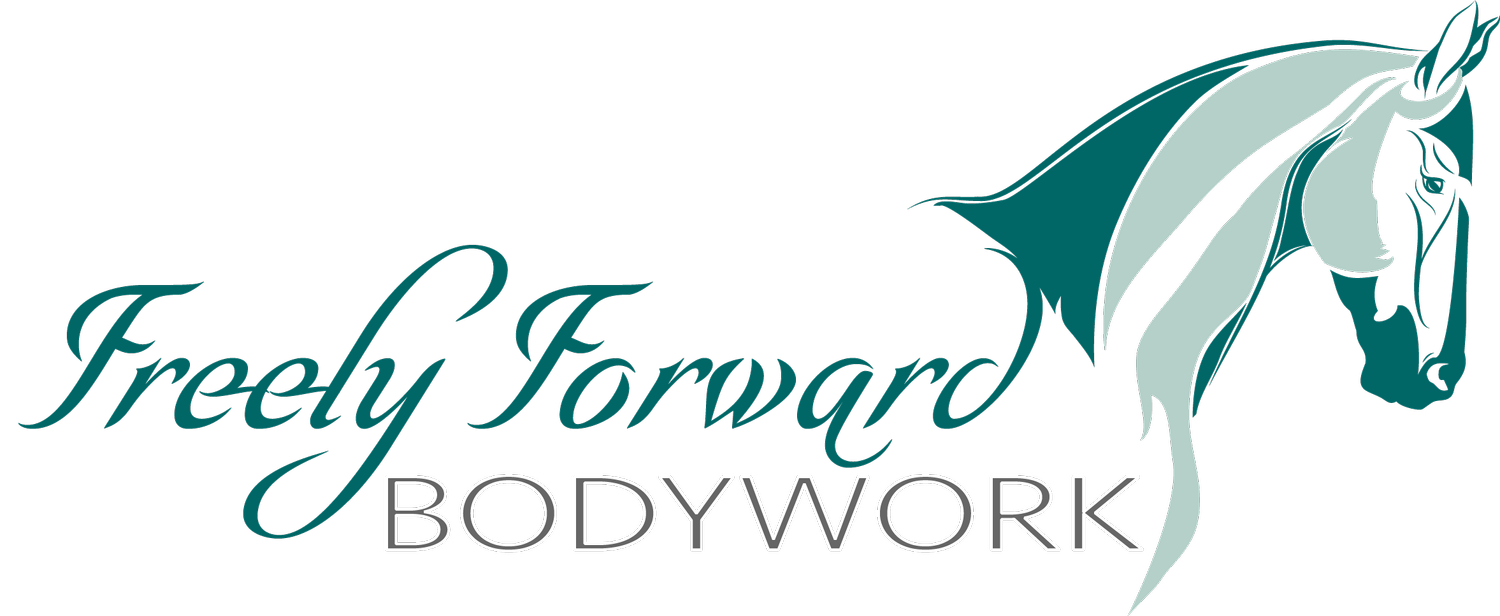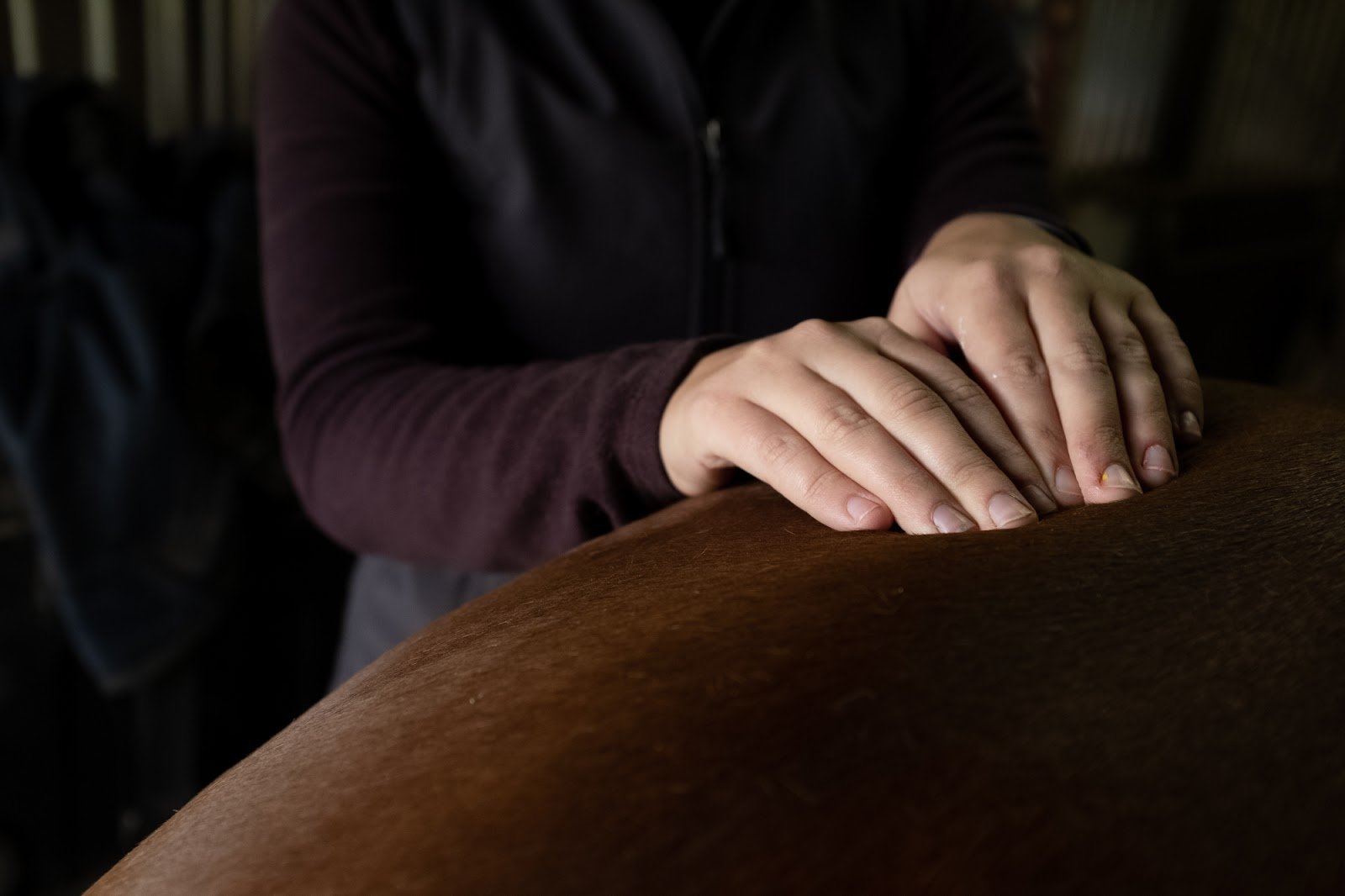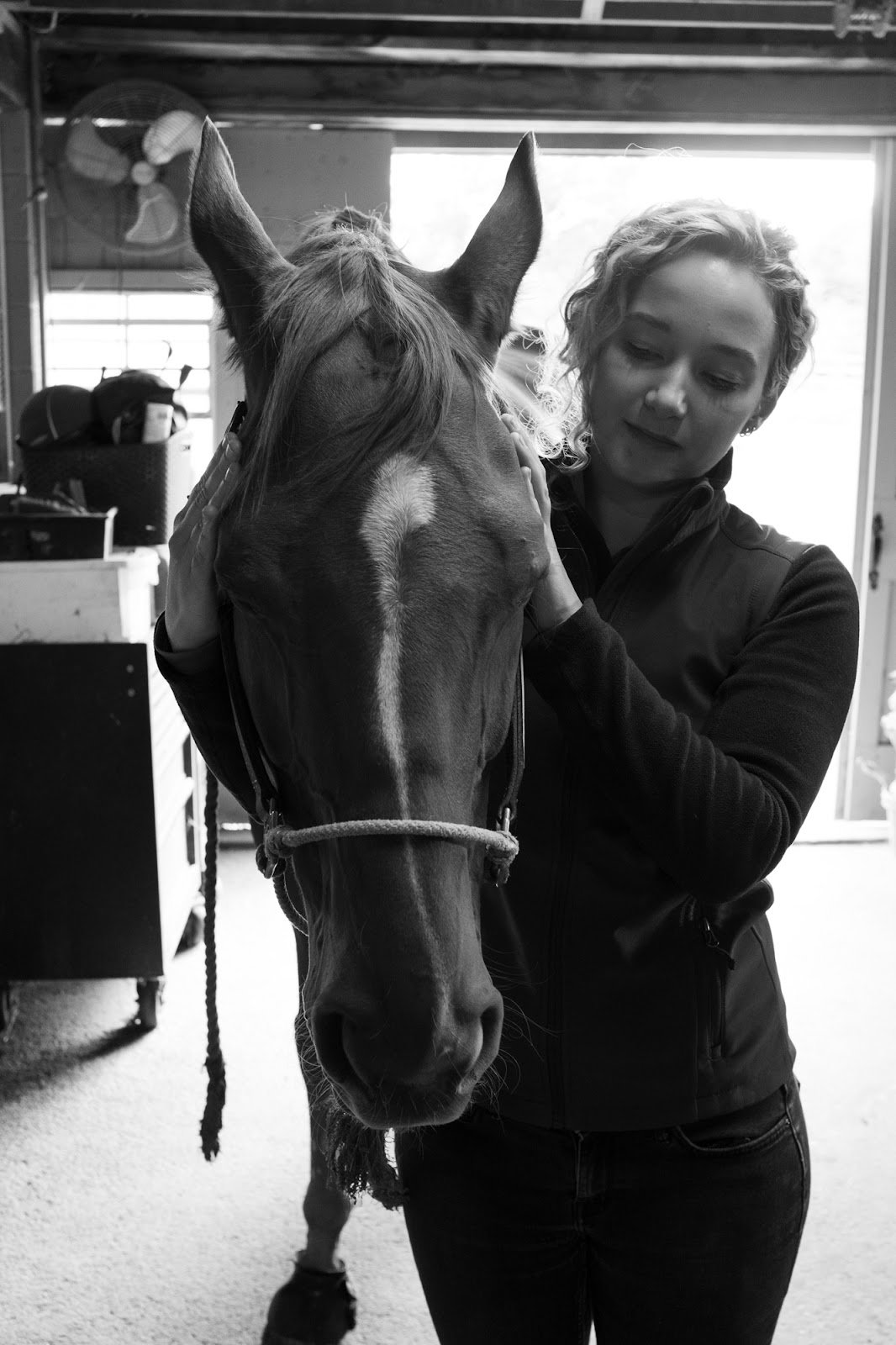Take a sneak peak into what awaits you in Equine Massage 101!
EQUINE MASSAGE 101 SNEAK PEAK
Welcome to
Equine Massage 101
Led by licensed massage therapist Maija Luttinger, Equine Massage 101 will break down equine myofascial release techniques step by step. These techniques are simple but very effective. The course strikes a balance of being extremely thorough (it features 131 video lessons to help you learn) and easy to follow and understand. Each of the massage and stretching techniques the lessons teach you will help you bring out the best in your horse and help them perform to the best of their ability.
As soon as you purchase the course, you’ll gain lifetime access to all of the content. This structure grants you the ability to progress at your own pace and revisit lessons whenever you like. Your access to the course never expires, either!
By the time you finish the course, you’ll become your horse’s personal massage therapist. Get started today and see results in your horse before you know it!
Why not dip your feet into the world of Equine Massage 101 with our free online webinar? All you have to do is sign up below!
“Maija Freely Forward Bodywork has done incredible work with the horses in my program. Her skill with the horses is amazing but even more so is her engagement with myself, my staff and clients. Here at FBE we are excited to jump in and learn a little of the magic Maija works. My staff, students and I have signed up to learn about some massage techniques, so we can keep the work going that Maija does with our horses.”
— Fylicia Barr, 5* eventer
Full Course Specifications
Ready to go all in? Check out the full course specifications below and find out what you will be learning on this jounrney.
Your purchase of our Equine Massage 101 course grants you lifetime access to the entirety of its content. Take your time; it’s not going anywhere! Use it as a tool going forward anytime you need a refresher on anatomy, a massage technique, or anything at all.
-
Disclaimer
About Me
Course Topics
Specials thanks to DQ Performance Horses
-
Abdominal and Oblique Muscles
View From Below the Horse, Muscles
Skeletal Anatomy
Superficial, Midlevel, and Deep Overall Muscle Anatomy Images
-
Overall Anatomy
Skeletal Anatomy and Bony Landmarks
Overall Muscular Anatomy
What is Fascia?
Fascial Layers Image
Facial Adhesions
The Importance of the Muscular and Fascial Systems
Equine Fascial System
Recommended Reading/Additional Education
Why is it Important to Keep Muscles Flexible?
What Causes Muscle Issues?
Overall Signs Your Horse is in Muscular Pain
Contraindications to Massage
Areas to Avoid While Massaging and Stretching
Equine Safety
Before We Start: Palpating Notes
The Do's and Don'ts of Palpating Your Horse
The Do's and Don'ts of Stretching
-
What is Myofascial Release?
Myofascial Release Basic Techniques
Basic Massage Principles
What's the Difference Between Massage and Myofascial Release?
What is a Massage "Release"?
How to Calibrate Your Pressure
Homework for Week 1
-
Signs Your Horse's Jaw is in Pain
TMJ Anatomy
How to Palpate and Check for Pain in the TMJ
TMJ Technique
TMJ Technique Troubleshooting
Masseter Techniques
Masseter Techniques Troubleshooting
Temporalis Technique
TMJ Management Recommendations
Suggested Homework for Week 2
-
Why is the Neck so Important?
Neck Muscle Image
Neck Anatomy
Brachiocephalicus in Action
Splenius in Action
Trapezius in Action
Atlas/Axis
Signs Your Horse's Neck is in Pain
How to Palpate and Check for Pain in the Neck
Splenius Technique and Troubleshooting
Poll Technique and Troubleshooting
Suggested Homework for Week 3
BONUS: Body Mechanics
BONUS: The Magic of Massage
-
Nuchal Ligament
The Nuchal Ligament, Cervical Vertebrae, and Scapula in Action
Trapezius Technique and Troubleshooting
Brachiocephalicus Technique and Troubleshooting
Neck Stretches
Neck Management Recommendations
Suggested Homework for Week 4
BONUS: Key Muscle Mechanics Concepts
Equine Ligament System Picture
-
Forelimb Skeletal Anatomy Image
Shoulder Muscle Image
Signs Your Horse's Shoulders are in Pain
How to Palpate and Check for Pain in the Shoulder
Shoulder Boney Landmarks
Deltoid Anatomy
Deltoid Technique
Deltoid Troubleshooting
Triceps Anatomy
Triceps Technique & Troubleshooting
Latissimus Anatomy
Latissimus Technique
Latissimus Troubleshooting
Suggested Homework for Week 5
-
Thoracic Sling Anatomy
Serratus Anatomy
Serratus Technique
Serratus Troubleshooting
Pectoral Anatomy
Pectoral Technique
Pectoral Troubleshooting
Shoulder Stretches
Shoulder Management Recommendations
Case Study: Bird's Sore Front Foot, and How it Affected Her Shoulders
Suggested Homework for Week 6
View Under the Horse Image
-
Signs Your Horse's Back is in Pain
How to Palpate and Test for Pain in the Back
Back Muscles Image
Longissimus Anatomy
Longissimus Technique
Longissimus Technique Troubleshooting
Multifidus Anatomy
Multifidus Technique
Multifidus Technique Troubleshooting
Iliocostalis Anatomy
Iliocostalis Technique
Iliocostalis Technique Troubleshooting
Suggested Homework for Week 7
-
Why are Your Horse's Core Muscles so Important?
Cross Hands Technique
Cross Hands Technique Troubleshooting
Back Stretches
Back Stretches Troubleshooting
Tail Pull Technique
Tail Pull Troubleshooting
The Iliopsoas Group
The Abdominal Group
The Obliques
Back Management Recommendations
Suggested Homework for Week 8
-
Stay Apparatus
Signs Your Horse's TFL/Quadriceps May Be in Pain
How to Palpate and Check for Pain in the TFL & Quadriceps
Quadriceps Anatomy
Quadriceps Technique
Quadriceps Technique Troubleshooting
TFL Anatomy
TFL Technique
TFL Technique Troubleshooting
Quadriceps/TFL Stretch
Quadriceps/TFL Stretch Troubleshooting
TFL and Quadriceps Management Recommendations
Suggested Homework for Week 9
-
Adductors Anatomy
Abduction vs. Adduction
Signs Your Horse's Gluteals May Be in Pain
Gluteal Group Anatomy
Gluteus Medius Techniques
Gluteus Medius Troubleshooting
Superficial Glute Anatomy
Superficial Glute Technique
Superficial Glute Technique Troubleshooting
Gluteal/Hamstring Stretch 1
Gluteal/Hamstring Stretch 1 Troubleshooting
Gluteal/Hamstring Stretch 2
Gluteal/Hamstring Stretch 2 Troubleshooting
Gluteal Group Management Recommendations
Suggested Homework for Week 10
-
Hamstring Anatomy
Signs Your Horse's Hamstrings May be in Pain
How to Palpate and Test for Pain in the Hamstrings
SS Ligament Palpation Technique
Example of an SS Reaction to Palpation
SS Massage Technique
SS Massage Technique Troubleshooting
Semitendinosus/Semimembranosus Technique
Semitendinosus/Semimembranosus Technique Troubleshooting
Biceps Femoris Anatomy
Biceps Femoris Technique
Biceps Femoris Technique Troubleshooting
Hamstring Management Recommendations
Suggested Homework for Week 11
-
Conformation and How it Affects your Horse
Gaits and Phases of Stride
Conformation and Phases of Stride Images (From Videos)
Case Study: Finn's Movement Improved Through Massage
Case Study: Claire's Transformation
Massage, Stretching, and Management for Optimal Performance: Interview with Tori Kager
After completing the course, you will be…
Let’s break it down
EDUCATED
You will gain the confidence that you CAN help your horse.
OPTIMISTIC
You will have a thorough understanding of your horse’s body, how to identify areas of discomfort or tension, and methods for how to help.
EMPOWERED
You will understand the path to getting your horse feeling their best and know that things WILL get better!

This is your day. This is the time to go after it all.
— ME, YESTERDAY
STILL WONDERING ABOUT SOMETHING?
Our Most Frequently Asked Questions
-
I developed Equine Massage 101 because I saw an incredible need for horse owners from all walks of life and all over the country to be able to help their horses independent of a professional. The course I developed is special because it is interactive and the education is high quality: any owner, trainer, or massage therapist would find value from it, but it is broken down and digestible enough to be accessible for an amateur owner who has limited time at the barn.
This course is made for you if:
You own or lease a horse and want to learn what you can do to help their muscle soreness and pain
Your horse is cold backed, tight in their neck, or sore in their hips
You are a beginner or amateur looking for a clinic that will teach you in depth about horses and their anatomy
You are a professional or seasoned amateur looking to put more tools in your toolbox to take the best care of your horses
You have an older horse that struggles with body soreness
You have a performance horse that needs to stay at their peak physical wellbeing
-
No, there is no time limit. Once enrolled, you are granted lifetime access to this course. Feel free to go at your own pace, whether that means taking your time or binging it all at once! You can revisit the lessons at any time, as well.
-
With purchase you are granted lifetime access to the course and all of its materials. You can always go back and view all the content as many times as you like.
-
Yes, upon finishing the training you get a certificate of completion!
-
This course offers a certificate of completion but does not offer certification for being a professional equine massage therapist. In my opinion, you should do in-person training before becoming a professional. The course is still an excellent first step in your journey to becoming an equine massage therapist! I have had many professional massage therapists take the course and get a lot out of it, so you only have the knowledge to gain here. The course is also quite affordable, so it’s a great way to get your feet wet in the equine massage industry before taking the plunge toward an official, professional certification.








